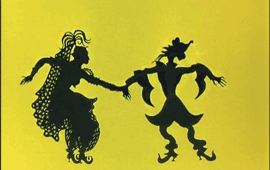> [Archived] Chronicles

The Adventures of Prince Achmed - Silent Film with Live Accompaniment at the Auditorium of the Romanian Athenaeum
The film is quite special; it is an animated film, the first animated feature in the history of cinema. But there's nothing resembling Ice Age or Kung Fu Panda about it. It does not even resemble the old animated films, the classics, such as Snow White or Tom and Jerry and the explanation is simple. This film is not a succession of drawings…but a succession of silhouettes cut out of paper through an amazing technique called Scherenschnitte/scissors cut. The amount of work was tremendous; it took three years to create the huge number of silhouettes needed so that the articulations of all characters be mobile and give the impression of natural movement. The imagination and the delicacy involved are astonishing. The historians decreed that this feature, The Adventures of Prince Achmed, is unique and its author - a big team was involved, but Lotte Reiniger, with her silhouettes cut out of paper, was the engine of the project - an exceptional artist.
As the title indicates, the protagonist is prince Achmed. The prince is delighted with a winged horse that the African sorcerer brings to the caliph's court. However, the price requested is impossible to pay: princess Dinarsade, the caliph's daughter and prince Achmed's sister. The prince still wants to put the horse's powers to the test, so he climbs it and soars. But he doesn't know how to control the magic animal which soared if one touched the ornament on its forehead and came down if a mechanism in its back was pressed. Achmed barely manages to land in a far-away country called Wak-Wak and ruled by demons. The demons hold captive a young woman, Pari Banu; Achmed sees her and is amazed at the girl's beauty. But Pari Banu is abducted by the African sorcerer who takes and sells her to the emperor of China. Of course, Achmed soars and fights to save the girl he loves. He will be successful, after fantastic adventures that take place in the five acts of the film, lasting 65 minutes. Achmed will be helped by the good witch and by Aladdin and his magic lamp.
The film available now is a version which was restored in 1989 by the German Film Museum and tinted according to the instructions left by Lotte Reiniger. Inspired by the beauty of the image, a lot of composers wrote music for this film. The original score was written by Wolfgang Zeller, one of the most in-demand German composers of film music, in direct co-operation with the author of the film, Lotte Reiniger. Other musicians followed in their steps: among them, the British Geoff Smith in 2008 or the Indian composer and guitarist Rahul Roy. The audience at the Romanian Athenaeum was presented the original score. On stage was the Romanian Youth Orchestra, led by the German conductor Stefan Geiger. As always, the young musicians' performance was impeccable. Inspired by the beauty of the image and by the conductor's passion and dedication, they recounted Achmed's adventures using sounds which contributed to persuading us of a princess' beauty, a sorcerer's wickedness or a prince's courage.
Via her film, The Adventures of Prince Achmed, Lotte Reiniger invited us for an hour in a magical universe, enjoyed by grown-ups and children alike.
Translated by Mihaela Olinescu and Elena Daniela Radu
MTTLC, Bucharest University














